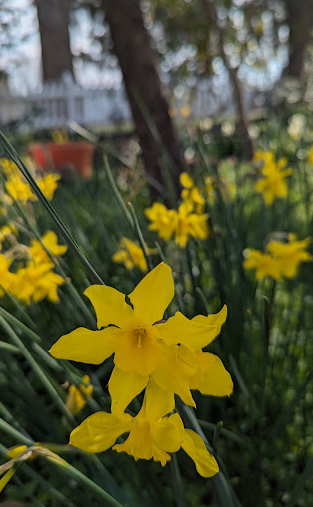5 Favorite Daffodils for the Deep South
- Clifford Brock
- Jan 9
- 3 min read
Updated: Jan 12
I used to be such a snob- particularly when it came to plants. Actually, I still am, but as I've gotten older and grown as a gardener, I'm seeing and appreciating flowers that I once ignored. One example is my relationship with the old bulbs around my mom's house.
When my folks bought the property in 1999, I didn't fully appreciate or even realize what treasures we were acquiring. At the time, I was obsessed with native plants and considered most exotics undesirable or even, God forbid, "invasive." I saw them as little more than background color, not as distinct species with a rich history. The only thing I noticed about them was that they came up in straight lines throughout the yard. Most were daffodils, but there were also rows of snowflakes (Leucojums) or silverbells, as the locals call them, and purple Roman Hyacinths- which, btw, smell delicious!
But time changes us, and fast-forward to 2025, and I've become a reformed heirloom bulb fanatic! Before I forget to tell you, all of these daffodils don't require division to keep blooming... I haven't done anything to them in the 20+ years we've been here.

Perhaps our most common Narcissus (the genus of daffodils) is an ancient hybrid between two Narcissus species. 'Campernelle', as it is known, is a hybrid between the dainty little N. jonquilla and the more typical-looking "daffodil" type N. pseudonarcissus (Common daffodil or Lent Lily), both of which are also found in abundance.
Campernelles resemble larger versions of jonquils and have narrow, cylindrical leaves and a heavenly sweet scent. These are tough survivors and can live for centuries, often long after the old homeplace has rotted away. You can find rows of these in the surrounding pastures, along with all the others on my list. I'm told they are sterile, so they don't produce seed, but they do prolifically offset (or produce new bulbs that can easily be divided.)

Another common daffodil in our yard is the aptly named 'Butter and Eggs'. As you can see in the photo, it has a dense swirled yellow and white center reminiscent of scrambled eggs. It does, however, produce top-heavy blooms that tend to fall over after heavy Spring showers. Otherwise, it's a reliable addition to the Southern heirloom landscape.
Another ubiquitous one is known simply as Narcissus x incomparabilis . This plant must have a better, more precise cultivar name, but I've yet to learn it. If you go to Southern Bulb Company's website, it is listed as the "Incomparable" daffodil: https://www.southernbulbs.com/narcissus-incomparabilis-incomparable-heirloom-daffodil/.

'Incomparabilis' blooms just after my 'Campernelles' (usually early March) but doesn't have the sweet fragrance of jonquils. But it makes up for it by having a white and yellow or bicolor bloom shaped like a pinwheel that looks like it would spin on a windy day.
Though less numerous in our yard, jonquils are also found in little pockets throughout the landscape. This would probably be my favorite Narcissus if I had to pick just one! I love its cuteness and narrow rush-like leaves that pop up in early winter. It also has a sweet perfume and makes for a nice cut flower! I like to put mine above the sink so that I can sniff them when washing dishes. Jonquils readily produce seed, and I can find them "naturalizing" in the lawn around the mother plant. They can bloom anytime from March till early April.


Lastly, I'd like to mention the Tazetta daffodils. These are big, bold, and brassy Narcissus that look like more refined paperwhites. They bloom early but usually much later than paperwhites (usually late February). These have a fruity fragrance far more pleasant than the musky, overpowering fragrance of paperwhites. While the exact identity of the one in our yard remains a mystery, it could be 'Avalanche,' sometimes called 'Seventeen Sisters.' These are also sold at Southern Bulb Company.
All of these look great in combination with each other and with other bulbs like snowflakes (Leucojum), crocus, Roman Hyacinths, and Ipheion or Spring Star Flower. Because daffodils grow in the cool season, producing foliage and flowers early in the year, please don't cut them back until the foliage starts to yellow and wither, usually mid-May for me. Some, like jonquils, also produce foliage as early as November, so avoid mowing them then. Otherwise, plant them once, and you'll have lifetimes of fragrance, color, and more than enough to share with your friends!
Here are some honorable mentions that also perform great in our yard:
'Carlton'
'Sweetness'
'February Gold'
'Rijnveld's Early Sensation'
'Geranium'

Comments